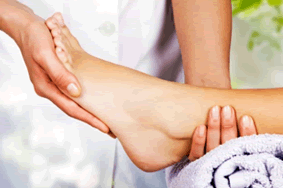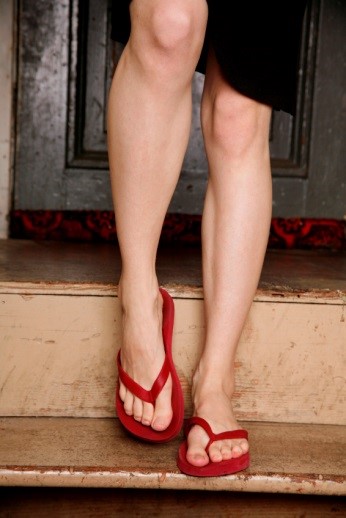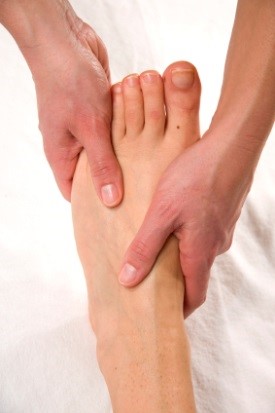Blog
Australians Seeking Botox Injects to Reduce Sweaty Feet
 Australians have recently been found to reduce hyperhidrosis of the feet with the help of Botox injections. According to neurologist and clinical professor Dr. Peter Silbert of University of Western Australia, when Botox is injected near a sweat gland, it blocks communication between the gland and the nerves. This is said to prevent excessive sweating in the area, but the area must be injected every six months which comes with side effects such as weakness.
Australians have recently been found to reduce hyperhidrosis of the feet with the help of Botox injections. According to neurologist and clinical professor Dr. Peter Silbert of University of Western Australia, when Botox is injected near a sweat gland, it blocks communication between the gland and the nerves. This is said to prevent excessive sweating in the area, but the area must be injected every six months which comes with side effects such as weakness.
If you are suffering from hyperhidrosis contact Dr. Michael E. Newman from Pennsylvania. Our doctor will treat your foot and ankle needs.
Hyperhidrosis of the Feet
Hyperhidrosis is a rare disorder that can cause people to have excessive sweating of their feet. This can usually occur all on its own without rigorous activity involved. People who suffer from hyperhidrosis may also experience sweaty palms.
Although it is said that sweating is a healthy process meant to cool down the body temperature and to maintain a proper internal temperature, hyperhidrosis may prove to be a huge hindrance on a person’s everyday life.
Plantar hyperhidrosis is considered to be the main form of hyperhidrosis. Secondary hyperhidrosis can refer to sweating that occurs in areas other than the feet or hands and armpits. Often this may be a sign of it being related to another medical condition such as menopause, hyperthyroidism and even Parkinson’s disease.
In order to alleviate this condition, it is important to see your doctor so that they may prescribe the necessary medications so that you can begin to live a normal life again. If this is left untreated, it is said that it will persist throughout an individual’s life.
A last resort approach would be surgery, but it is best to speak with your doctor to find out what may be the best treatment for you.
If you have any questions, please feel free to contact our offices located in Plymouth Meeting and Ambler, PA. We offer the newest diagnostic and treatment technologies for all your foot and ankle needs.
How to Prevent Blisters From Running Shoes
 Runners, although faced with many potential foot and ankle issues, often face blisters on the feet due to the friction between the foot and shoe. Accordingly every shoe comes with an extra set of shoe lace holes that help prevent this friction on the foot by tightening the fit of the shoe. When lacing the shoe, each lace should be inserted into the extra hole creating a loop. The laces are then crossed into each loop on the other side of the shoe and then tied as normal. Runners can also try moisture free socks or put petroleum jelly on their feet before a run to reduce friction and prevent blisters.
Runners, although faced with many potential foot and ankle issues, often face blisters on the feet due to the friction between the foot and shoe. Accordingly every shoe comes with an extra set of shoe lace holes that help prevent this friction on the foot by tightening the fit of the shoe. When lacing the shoe, each lace should be inserted into the extra hole creating a loop. The laces are then crossed into each loop on the other side of the shoe and then tied as normal. Runners can also try moisture free socks or put petroleum jelly on their feet before a run to reduce friction and prevent blisters.
Blisters are prone to making everyday activities extremely uncomfortable. If you have any concerns with blisters on your feet contact Dr. Michael E. Newman and Dr. Denise Kohler of Pennsylvania. Our doctors will treat your foot and ankle needs.
Foot Blisters
Foot blisters develop as a result of constantly wearing tight or ill-fitting footwear. This happens due to the constant rubbing from the shoe, which can often lead to pain.
What are Foot Blisters?
A foot blister is a small fluid-filled pocket that forms on the upper-most layer of the skin. Blisters are filled with clear fluid and can lead to blood drainage or pus if the area becomes infected.
How do Blisters Form?
Blisters on the feet are often the result of constant friction of skin and material, usually by shoe rubbing. Walking in sandals, boots, or shoes that don’t fit properly for long periods of time can result in a blister. Having consistent foot moisture and humidity can easily lead to blister formation.
Prevention & Treatment
It is important to properly care for the affected area in order to prevent infection and ease the pain. Do not lance the blister and use a Band-Aid to provide pain relief. Also, be sure to keep your feet dry and wear proper fitting shoes. If you see blood or pus in a blister, seek assistance from a doctor.
If you have any questions please feel free to contact our offices located in Plymouth Meeting and Ambler, PA. We offer the newest diagnostic tools and technology to treat your foot and ankle needs.
Quality Shoe Materials can help prevent Foot Problems
 Leo Faramelli of Leo’s Shoe Repair has a lot of experience selling and repairing shoes and has a vast understanding of how certain shoes can cause problems for the feet. “Older shoes are made a lot better. There’s much more real leather. Today, most of the shoe is vinyl to an extent,” Leo states. Today shoes are made with a cheaper grade of leather than is then coated with vinyl and plastic. The shoes look great but that are not as quality, putting customers feet at risk for problems such as corns. Shoes made out of real leather will mold to your feet.
Leo Faramelli of Leo’s Shoe Repair has a lot of experience selling and repairing shoes and has a vast understanding of how certain shoes can cause problems for the feet. “Older shoes are made a lot better. There’s much more real leather. Today, most of the shoe is vinyl to an extent,” Leo states. Today shoes are made with a cheaper grade of leather than is then coated with vinyl and plastic. The shoes look great but that are not as quality, putting customers feet at risk for problems such as corns. Shoes made out of real leather will mold to your feet.
Shoes that are not properly suited for the feet can cause corns and other podiatric problems. If you have any foot or ankle concerns, contact Dr. Michael E. Newman of Pennsylvania. Our doctor will attend to your foot and ankle needs.
Corns: What are they? And how do you get rid of them?
Corns can be described as areas of the skin that have thickened to the point of becoming painful or irritating. They are often layers and layers of the skin that have become dry and rough, and are normally smaller than calluses.
Ways to Prevent Corns
There are many ways to get rid of painful corns such as wearing:
- Well-fitting socks
- Comfortable shoes that are not tight around your foot
- Shoes that offer support
Treating Corns
Treating corns involves removing the dead skin that has built up in the specific area of the foot. Salicylic acid can help in getting rid of these corns because it dissolves keratin, which is the protein that makes up a good majority of corns. Podiatrists recommend that people with diabetes not use salicylic acid but should consult with their podiatrist regarding the treatment of corns.
If you have any questions feel free to contact our offices located in Plymouth Meeting and Ambler, PA. We offer the newest diagnostic tools and technologies to treat your foot and ankle needs.
Reasons to Avoid Flip Flops This Summer
 As the weather begins to transition into a warmer atmosphere, many individuals will want to slip into more comfortable flip-flops; however, Cosmopolitan has come up with a few reasons why you should avoid the shoe type this season. Flip-Flops expose the feet to bacteria and other infections that can cause irritation to the skin as well as exposing the feet to athlete’s foot and HPV the cause of plantar warts. Studies have also shown that flip flops cause you to slow down and make you clumsier because of the shorter stride you would have to take while wearing the shoe. The thin strap that keeps the shoe on the foot is also a major cause of blisters and the thin foam in between the foot and the ground often cause heel pain, poor posture, shooting pains, and other foot problems.
As the weather begins to transition into a warmer atmosphere, many individuals will want to slip into more comfortable flip-flops; however, Cosmopolitan has come up with a few reasons why you should avoid the shoe type this season. Flip-Flops expose the feet to bacteria and other infections that can cause irritation to the skin as well as exposing the feet to athlete’s foot and HPV the cause of plantar warts. Studies have also shown that flip flops cause you to slow down and make you clumsier because of the shorter stride you would have to take while wearing the shoe. The thin strap that keeps the shoe on the foot is also a major cause of blisters and the thin foam in between the foot and the ground often cause heel pain, poor posture, shooting pains, and other foot problems.
Flip-flops can cause a lot of damage to the feet and rest of the body. If you have any concerns about your foot and ankle needs contact Dr. Michael E. Newman and Dr. Denise Kohler of Pennsylvania. Our doctor will treat your foot and ankle needs.
Flip-Flops and Feet
Flip-flops are not only very popular, but very convenient, especially in the warmer weather. They allow your feet to breathe and let you move your toes freely. They also go with most attire and can be worn with many different clothing styles. Unfortunately, these type of shoes also have a disadvantage, as they can cause harm to your feet in more ways than you think. These symptoms include:
- Ball and arch problems in the foot
- Changes to the body’s natural gait
- Blisters
- Ankle Sprains
- Higher risk of infection
- Higher risk of scrapes and cuts to the feet
- Issues in the lower back, legs and ankles
To avoid these symptoms (and minimize your risks), select a pair of flip-flops made of high quality materials that can offer protection. Purchase flip-flops from a reliable manufacturer and be sure to replace them every three to four months. Be sure the soles are firm and not ‘floppy’, or that they don’t bend or wiggle a lot when lifted from the floor.
You can still wear your favorite pair of flip-flops if you so choose, just don’t wear them for extended periods of time, and especially not every day. However, it would be far wiser to purchase a more expensive pair of flip-flops or to refrain from wearing the shoe at all for the sake of your foot health. While these shoes are comfortable, the risks included with wearing them are not.
If you have any questions please feel free to contact our offices located in Plymouth Meeting and Ambler, PA. We offer the newest diagnostic tools and technology to treat your foot and ankle needs.
